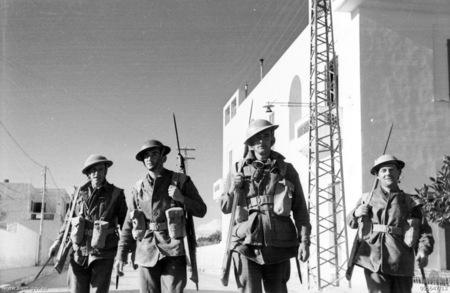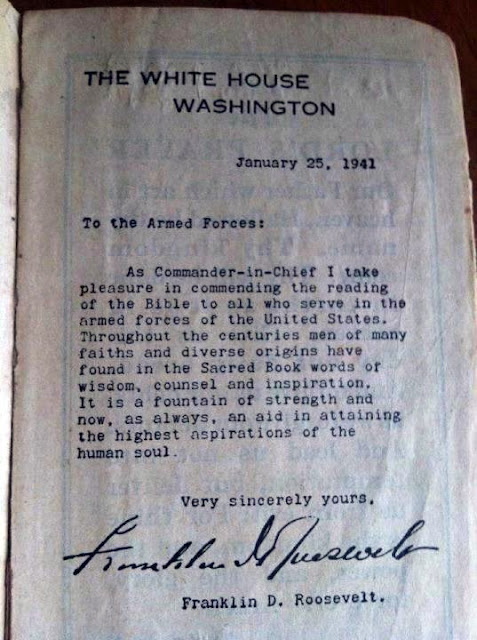Saturday 25 January 1941
 |
| Australian troops at Tobruk, 25 January 1941. |
However, the weather is horrendous in the mountains. Not only are the Italians suffering from frostbite, but there also is an outbreak of typhoid fever. The Greek forces, of course, face the same conditions. However, they have the advantage of help from the local Albanian inhabitants, who strongly support the Greeks whom they view as liberators and often have family ties that cross the border.
East African Campaign: The British troops continue advancing past the Keru Gorge toward Agordat, a key crossroad. The Italian troops are falling back on the city in disorder. Gazelle Force advances to Biscia.
The British open a new attack by Nigerian, Ghanaian, East African, and South African troops of 11th African Division under British General Harry Edward de Robillard Wetherall, as well as 12th African Division under British General Reade Godwin-Austen. They enter Italian Somaliland from Kenya. The Italians immediately withdraw behind the Juba River, 100 miles behind the border. This is the "Southern Front."
European Air Operations: RAF Bomber Command raids the U-boat pens at Lorient. The Luftwaffe only sends over a few attackers during the day and night.
 |
| Norwegian freighter Elisabeth Bakke, one of the ships that successfully escaped from Sweden to Scotland. © IWM (A 9976). |
- 5460-ton Elizabeth Bakke
- 4718-ton John Bakke
- 6962-ton Tai Shan
- 4767-ton Taurus
- 6355-ton Ranja
Force J, composed of the aircraft carrier HMS Hermes and light cruiser HMS Enterprise, is operating out of Dakar and searching for Admiral Scheer and other German commerce raiders. It doesn't find them, but it does intercept Vichy French 8917 ton freighter Sontay and escort it to Durban.
British 178 ton coaster Spey runs aground at Warkworth, Northumberland and is lost.
U-105 (Kapitänleutnant Georg Schewe) does everybody a favor and torpedoes and sinks the burning derelict 3564-ton British freighter Lurigethan. The ship was abandoned by its crew west of Ireland after attacks by KG 40 Focke-Wulf Fw-200 Condors on 23 January.
British Admiral Sir John Tovey takes the Home Fleet out of Scapa Flow at 23:20 for the Faeroes Gap in order to intercept German battlecruisers Scharnhorst and Gneisenau. The forces include battleships HMS Nelson and Rodney, the battlecruiser HMS Repulse and three light cruisers of the 2nd Cruiser Squadron.
Making efficient use of its assets, the Admiralty has battleship King George V in the Chesapeake Bay after having brought across Lord Halifax, join the escort for Convoy BHX 104.
German raider Pinguin sails with its captured Norwegian whaling vessels for the South Atlantic for a rendezvous in the South Atlantic with supply ship Nordmark.
Convoy FN 391 departs from Southend, Convoy AS 13 departs from Pireaus for Port Said, Convoy BS 13A departs from Suez, Convoy HX 105 departs from Halifax.
U-201 (Adalbert Schnee) commissioned, U-79 and U-501 launched, U-600 laid down.
US battleship USS Wisconsin (BB-64, Iowa Class) is laid down at the Philadelphia Navy Yard. This is the last battleship ever laid down by the US Navy. Submarine USS Gudgeon is launched at Mare Island, California.
 |
| USS Gudgeon is launched today. |
Another related battle takes place to the north, at Derna airfield. The Babini Group's supporting Italian infantry, the 60th "Sabratha" Division, takes heavy casualties against the 2/11th Australian Battalion and the 19th Australian Brigade. The Italians use their planes to good effect, and the flat ground makes the attacking Australians extremely vulnerable. The Italians hold their positions throughout the day despite the heavy casualties, but the British are bringing up more forces while the Italian force is being whittled away.
After dark, ten Fliegerkorps X Stukas, perhaps patrolling to find HMS Illustrious and its escorts (which all make port at Alexandria during the day), find other targets. They spot and attack British minelaying cruiser HMS Latona and several accompanying destroyers off Tobruk. Latona is damaged by a 500 kg bomb and sinks at 22:30 after the ship's magazine blows up. There are 27 deaths. In addition, destroyer HMS Hero is damaged by near-misses. Illustrious, meanwhile, is now safe from air attack and can proceed via the Suez Canal to the United States for permanent repairs.
At Malta, an Italian Cant Z501 flying boat lands off Comino and the crew surrenders. The British go out and arrest them, but are puzzled about why the flying boat landed there (the crew never intended to surrender). The crew explains that they were lost and running low on fuel, and they mistook British searchlights for a signal from their base at Augusta. The large flying, incidentally, sinks in the rough seas.
The RAF on Malta begins air operations against Italian convoys to North Africa, though at first only reconnaissance is performed.
 |
| Collier's January 25, 1941, Vol. 107, No. 4. Cover Art by Earl Oliver Hurst. |
US Government: Former Ambassador William C. Bullitt testifies before the House Foreign Affairs Committee and gives his own view of the current strategic situation. Bullitt warns that "our own self-preservation" requires that the United States support Great Britain against Germany. His argument is that the Royal Navy protects the United States and that it might take too long to get the US fleet from Hawaii to defend the East Coast.
Bulgaria: Pursuant to the original orders of the Wehrmacht of 11 December 1941, today was to have been when Field Marshal Wilhelm List was to have been ready to cross the Danube from Romania into Bulgaria. However, it is a cold winter, and rail traffic from Germany has been essentially stopped since 4 January, hurting logistical preparations. List only has about two armored and two infantry divisions in place. This is much too weak for an invasion, not necessarily because of Bulgarian strength, but because of the possibility that Turkey will intervene on Bulgaria's side (or perhaps to occupy Bulgaria itself) with its dozens of divisions. In addition, the Romanian airfields are in terrible shape and insufficient to support the required Luftwaffe forces. The new date for the invasion of Bulgaria is fixed at 24 February, but it is unclear if these difficulties will clear up by then, either. An invasion of Bulgaria will not be necessary, of course, if Bulgaria decides to join the Tripartite Pact, to which its leaders are currently giving hard thought and beginning to lean in favor of joining.
Okamura, incidentally, is a fascinating/loathsome character for a number of reasons. He began the policy of "comfort women" for Japanese troops in China and, despite being convicted of war crimes, never is punished for those crimes on the personal order of Chiang Kai-shek.
Separately, the Japanese 11th Army opens an offensive against the Chinese 5th War Area in the region of Hsaiolintien, Mingkang, and Chengyang. This is known as the Battle of Southern Honan.
British Homefront: One of the odder pieces of trivia about World War II is that animals sometimes receive medals. Chum the Airedale, who saved the life of Mrs. Marjorie French of Purley when he dug her out of a bombed-out house and dragged her to safety, is awarded the Bravery Medal of Our Dumb Friend's League, aka the "Dog's VC." The word "Dumb" in this context, incidentally, is meant in its classical sense of "unable to speak," not "stupid." This is the first animal medal of the war, but not the last.
 |
| Chum the Airedale. |
January 1941
January 1, 1941: Muselier ArrestedJanuary 2, 1941: Camp Categories
January 3, 1941: Liberty Ships
January 4, 1941: Aussies Take Bardia
January 5, 1941: Amy Johnson Perishes
January 6, 1941: Four Freedoms
January 7, 1941: Pearl Harbor Plans
January 8, 1941: Billions For Defense
January 9, 1941: Lancasters
January 10, 1941: Malta Convoy Devastation
January 11, 1941: Murzuk Raid
January 12, 1941: Operation Rhubarb
January 13, 1941: Plymouth Blitzed
January 14, 1941: V for Victory
January 15, 1941: Haile Selassie Returns
January 16, 1941: Illustrious Blitz
January 17, 1941: Koh Chang Battle
January 18, 1941: Luftwaffe Pounds Malta
January 19, 1941: East African Campaign Begins
January 20, 1941: Roosevelt 3rd Term
January 21, 1941: Attack on Tobruk
January 22, 1941: Tobruk Falls
January 23, 1941: Pogrom in Bucharest
January 24, 1941: Tank Battle in Libya
January 25, 1941: Panjiayu Tragedy
January 26, 1941: Churchill Working Hard
January 27, 1941: Grew's Warning
January 28, 1941: Ho Chi Minh Returns
January 29, 1941: US Military Parley With Great Britain
January 30, 1941: Derna Taken
January 31, 1941: LRDG Battered
2020

No comments:
Post a Comment